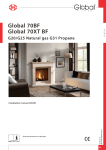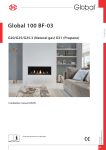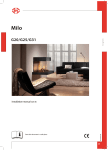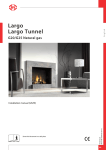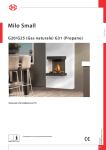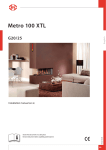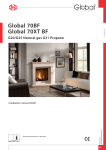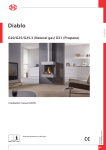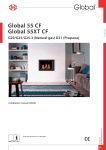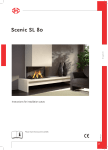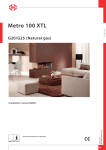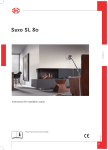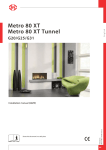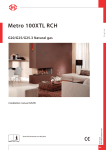Download Installation manual - Dru site for the trade
Transcript
English Milo Small G20/G25 (Natural gas) G31 (Propane) Store this document in a safe place 959.030.04.UK DRU46686-184218-EN--0713-3 Installation manual (GB/IE) UK INSTAL L ATIO N MA N U A L Contents English 1. Introduction 2. CE declaration 3. SAFETY 3.1 General 3.2 Regulations 3.3 Precautions/safety instructions during installation 3.4 Second thermocouple safety 4. Disimballo 5. Installazione 5.1 Type of gas 5.2 Gas connection 5.3 Placing the appliance 5.4 Flue gas discharge / combustion air supply system 5.4.1 General 5.4.2 Application with wall terminal 5.4.2.1 Construction of concentric system with wall terminal 5.4.2.2 Placing concentric system with wall terminal 5.4.3 Application with roof terminal 5.4.3.1 Construction of concentric system with roof terminal 5.4.3.2 Placing concentric system with roof terminal 5.4.4 Connection of existing chimney 5.5 Placing the chimney breast 5.5.1 Placing the narrow chimney brest 5.6 Connecting gas 5.7 Adjusting the appliance 5.7.1 Restrictor slide 5.7.2 Air inlet guide 5.7.2.1 Removing the air inlet guide 5.8 Placing the wood set 5.9 Glass panes 5.9.1 Front glass pane 5.9.1.1 Removing the front glass pane 5.9.1.2 Placing the front glass pane 5.9.2 Side glass panes 5.9.2.1 Removing the side glass pane 5.9.2.2 Placing the side glass pane 5.10 Finishing the appliance 6. Wireless remote control 6.1 Connecting the receiver 6.1.1 Placing / replacing the receiver's batteries 6.2 Setting the communication code 7. Final inspection 7.1 Gastightness 7.2 Gas pressure/line-pressure 7.3 Ignition pilot and main burner 7.3.1 First ignition of the appliance after installation or adjustments 7.3.2 Main burner 7.4 Flame picture 8. Maintenance 8.1 Parts 9. Delivery 10. Malfunctions Appendix 1 Diagnosis of malfunctions Appendix 2 Various tables Appendix 3 Figures UK INST AL L AT I ON M AN U A L 1. Introduction English DRU, a manufacturer of gas-fired heating appliances, develops and produces products that comply with the highest quality, performance and safety requirements. This appliance has a CE label, which means that it complies with the essential requirements of the European gas appliance directive. The appliance is supplied with an installation manual and a user manual. As an installer, you must be certified and competent in the field of gas-fired heating. The installation manual will give you the information you need to install the appliance in such a way that it will operate properly and safely. This manual discusses the installation of the appliance and the regulations that apply to the installation. In addition, you will find the appliance’s technical data as well as information on maintenance, possible malfunctions that might occur and what may cause them. The figures can be found at the back of this booklet, in the appendix. Please, read and use this installation manual carefully and completely, prior to installing this appliance. If you use the DRU Powervent system®, the DRU Smartvent system® or the DRU Maxvent system®, you must carefully and fully read and use the accompanying installation manual as well, prior to its installation. Ø !Tip !Caution !Caution The following symbols are used in the manual to indicate important information: Work to be performed Suggestions and recommendations You will need these instructions to prevent problems that might occur during installation and/or use. You need these instructions to prevent fire, personal injury or other serious damages. After delivery, you should give the manuals to the user. 2. CE declaration We hereby declare, that the design and construction method of the gas-fired heating appliance issued by Dru complies with the essential requirements of the gas appliance directive. Product: gas-fired heating appliance Type: Milo Small EEC directives: 2009/142/EC Standards: NEN-EN-613 NEN-EN-613/A1 Internal precautions at the company will guarantee that appliances produced in series comply with the essential requirements of the EC directives in force and the standards derived from them. This declaration will lose its validity if adjustments are made to the appliance, without prior written permission by DRU. M.J.M. Gelten General manager Postbus 1021, 6920 BA Duiven Ratio 8, 6921 RW Duiven www.dru.nl UK INSTAL L ATIO N MA N U A L 3. SAFETY 3.1 General !Caution - Carefully read this chapter on safety, before you start performing installation or maintenance work; Please observe the general regulations and the precautions/safety instructions in this manual. 3.2 Regulations English Please install the appliance in accordance with the applicable national, local and constructional (installation) regulations. 3.3 Precautions / safety instructions during installation Ø Carefully observe the following precautions/safety regulations: You should only install and maintain the appliance if you are a certified and competent installer in the field of gas-fired heating; Do not make any changes to the appliance; If you are installing an appliance that must be built in; use non combustible and heat-resistant material for the chimney breast, including the top of the chimney breast, the material inside the chimney breast and the back wall against which the appliance will be placed. For this you can use both sheet material and stone-like materials; take sufficient measures to prevent high temperatures of the wall behind the chimney breast, including the materials and/or objects that are behind the wall; comply with the minimum required internal measurements of the chimney breast; vent the chimney breast by means of ventilation holes with a combined passage as stated further down in the text; use heat-resistant electric connections and make sure that they do not make contact with the appliance; If you are installing an appliance with an open combustion: use a suitable flue gas discharge system that is provided with the CE label; if you are installing an appliance with a closed combustion: only use the concentric systems supplied by DRU; if you are installing a free-standing appliance: place the appliance away from the back wall by the minimum distance stated further down in the text; do not cover the appliance and/or do not wrap it in an insulation blanket or any other material; make sure that combustible objects and/or materials have a distance from the appliance of at least 500 mm only use the accompanying wood/pebble set and place it exactly as described; the space surrounding the pilot burner, 2nd thermocouple or ionisation pins must remain free; make sure there is no dirt in gas pipes and connections; place a gas tap in accordance with applicable regulations; prior to putting into operation, check the complete installation for gastightness; if your appliance is provided with explosion hatches on its top, you must make sure that they cannot be blocked and check whether they fit well onto the sealing surface, prior to building in the appliance; do not ignite the appliance before the gas and discharge connections have been fully installed, first observe the procedure described in chapter 7.3. replace broken or torn glass panes. !Caution In case of broken or torn glass panes, the application may not be used. Ø Ø Ø Ø Ø Ø Ø Ø Ø Ø Ø Ø Ø Ø Ø 3.4 Second thermocouple safety (if applicable, see Appendix 2, Table 2) It is possible, that the appliance to be installed has 2 thermocouples. Thermocouple 1 is always next to the pilot burner, thermocouple 2 is always elsewhere above the main burner. If the appliance is provided with a second thermocouple safety on the main burner, you need to know that it will intervene if no proper transfer has taken place from the pilot burner to the main burner or from the main burner itself. The gas supply will be interrupted after 22 seconds. In order to solve a poor or non-existent transfer from the pilot burner to the main burner, please use the malfunction search diagram in Appendix 1. UK INST AL L AT I ON M AN U A L 4. Removing the packaging Note the following items when removing the packaging: Check the appliance and accessories for damages (during transport). If necessary, contact your supplier. Never install an appliance that is damaged ! Remove any screws that are used to fix the appliance to a platform or pallet. !Caution Heat-resistant glass is a ceramic material. Very small irregularities in the glass pane(s) cannot be avoided, but are within the required quality standards. !Caution Keep plastic bags away from children. Ø Ø In Appendix 2, Table 1 you can see which parts you should have after removing the packaging. Contact your supplier if you do not have all the parts after you finished removing the packaging. Dispose of packaging in accordance with local regulations. English Ø Ø Ø Ø UK INSTAL L ATIO N MA N U A L 5. Installation Read this manual carefully to ensure the proper and safe installation of the appliance. !Caution Install the appliance in the order described in this chapter. Ø Please install the appliance in accordance with the applicable national, local and constructional (installation) regulations. Observe the regulations/instructions in this manual. English Ø 5.1 Type of gas The data plate indicates for which type of gas, gas pressure and for which country this appliance is intended. The data plate can be found on the appliance or can be attached to a chain to which it should remain attached. !Caution Check whether the appliance is suitable for the type of gas and the gas pressure used at the location. !Tip If you want to convert this appliance into a different type of gas, please contact DRU's service department and ask what is possible. 5.2 Gas connection Place a gas tap in the gas pipe in accordance with the applicable regulations. !Caution Make sure there is no dirt in gas pipes and connections; The following requirements apply to the gas connection: use a gas pipe with the correct dimensions, so that no pressure loss can occur; the gas tap must be approved (in the EU this will be the CE mark); you should always be able to reach the gas tap. 5.3 Placing the appliance !Caution - Ø Take the minimum internal depth of the appliance into account (see Appendix 3, fig. 1). !Tip During manufacture, the spacer brackets on the appliance are mounted for the application of the rectangular flue gas discharge / combustion air supply system. Ø Ø Ø Ø Ø UK Attach the appliance to a wall of solid, non combustible and heat-resistant material; Take sufficient measures to prevent temperatures of a wall behind the chimney breast becoming too high, including the materials and/or objects behind the wall; Comply with the minimum required free space of 500 mm at both sides of the appliance, as well as above the appliance, because of the heat emission of the appliance; Make sure that combustible objects and/or materials have a distance from the appliance of at least 500 mm; Do not suspend the appliance too close to the wall; this is prevented by using the spacer brackets; Level the appliance horizontally and vertically, using the adjustable wall and spacer brackets; Do not cover the appliance and/or do not wrap it in an insulation blanket or any other material; Do not make any changes to the appliance. Place the appliance as follows: Determine the location of the appliance. Determine the suspension height of the appliance (see Appendix 3, fig. 1 and fig. 4a; Provide a gas connection at the location. For details, see section 5.2. Determine whether a rectangular or round flue gas discharge / combustion air supply system will be connected to the appliance’s flue spigot (see Appendix 3, fig. 1). Make a passage for the flue gas discharge/combustion air supply system with the following diameters. For details, see section 5.4: Ø 160 mm for a wall terminal through non combustible material; Ø 250 mm for a wall terminal through combustible material; Ø 160 mm for a roof terminal through non combustible material; Ø 250 mm for a roof terminal through combustible material. INST AL L AT I ON M AN U A L Ø Place the appliance on its destined location. When leading the rectangular flue gas discharge / combustion air supply system through a floor and/or ceiling, take the following dimensions into account; for details see section 5.4: 350x140 mm through non combustible material; 430x220 mm through combustible material. Check whether the position of the spacer brackets on the appliance is suitable for the chosen rectangular (A) or round (B) flue gas discharge / combustion air supply system (see Appendix 3, fig. 2). !Caution The spacer brackets are adjustable. Make sure they are adjusted correctly. Ø Loosen the screws of the spacer brackets (C) and turn the brackets around when a round system is used (see Appendix 3, fig. 2). Mount the appliance using the wall bracket and the key bolts supplied. Use the slot holes of the wall brackets to level the appliance horizontally (see Appendix 3, fig. 1, arrow 1). Use the adjustment bolts to level the appliance vertically (see Appendix 3, fig. 1, arrow 2). Ø Ø Ø English Ø Ø 5.4 Flue gas discharge / combustion air supply system 5.4.1 General The appliance is of the C11/C31 type. The appliance is connected to a combined flue gas discharge/combustion air supply system, hereafter referred to as the concentric system. The flue spigot of the appliance, is a rectangular, concentric version. To this you can connect a rectangular (A) (310x100 / 205x55 mm) and/or round (B) (Ø100 / Ø150 mm) concentric system (see Appendix 3, fig. 3a). The passage to the outside can be made with a wall terminal (see section 5.4.2) or a roof terminal (see section 5.4.3). If necessary, you can also use an existing chimney (see section 5.4.4). !Caution - - Only use the rectangular and/or round concentric system supplied by DRU. This system has been tested together with the appliance. DRU cannot guarantee a proper and safe operation of other systems and does not accept any liability for this; Always use coupling pieces with corresponding seals for the connections in the rectangular system. These are supplied with the system; see the accompanying instructions; Secure the coupling pieces with the self-tapping screws supplied; For connecting to an existing chimney you should only use the chimney kit supplied by DRU. The concentric system is constructed from (flue spigot of) the appliance. If structural circumstances require that the concentric system is placed first, the appliance can later be connected with a telescopic pipe piece, provided a round concentric system is used. In that case, an adapter to round must first be placed on the flue spigot. It is not possible to supply a telescopic pipe piece for a rectangular concentric system. 5.4.2 Application with wall terminal The wall terminal is a round concentric system. 5.4.2.1 Construction of concentric system with wall terminal !Caution - When using rectangular pipes it is only possible to end in the wall from which the appliance is suspended (there is no bend available for the concentric system); When the pipes end at right angles in the appliance, you can start with rectangular pipes, but you must change over to the round system. UK INSTAL L ATIO N MA N U A L English The concentric system with wall terminal has to comply with the following conditions: First, a concentric pipe of at least 1 meter should be connected vertically to the appliance; The total vertical pipe length may have a maximum of 4 meters; A fter the vertical part, a 90º bend (round system) or a squared adapter (rectangular system) is connected; When using a minimum of 1 meter up to a maximum of 4 meters of vertical pipe length, the total horizontal pipe length can have a maximum of 5 meters (excluding wall terminal, see Appendix 3, fig. 3b and fig. 3c). Depending on the construction of the concentric system, the appliance must receive further settings by removing the air inlet guide; see Table 1 for determining the conditions and section 5.7, Adjusting the appliance, for the method. 5.4.2.2 Placing concentric system with wall terminal !Caution - !Caution - Ø Ø Ø !Caution UK Maintain a distance of at least 50 mm between the outside of the concentric system and the walls, when using a round system; Maintain a distance of at least 23 mm between the outside of the concentric system and the walls, when using a rectangular system; this distance is fixed due to the construction of the rectangular system; Maintain a distance of at least 50 mm between the outside of the concentric system and the ceiling; Use non combustible material for building the concentric in, for instance, a cove; Use heat-resistant insulation material when passing through combustible material; The rosette (mounting inner plate) of the wall terminal is too small to seal the Ø 250 mm opening when passing through combustible material. That is why you should first apply a sufficiently large heat-resistant intermediate plate to the wall. Then, the rosette is mounted on the intermediate plate. When using rectangular pipes it is only possible to end in the wall from which the appliance is suspended (there is no bend available for the concentric system); When the pipes end at right angles in the appliance, you can start with rectangular pipes, but you must change over to the round system; Some heat-resistant insulation materials contain volatile components that will spread an unpleasant smell for a prolonged time; these are not suitable. Place the concentric system as follows: Build the system up from (the flue spigot of) the appliance. Connect the concentric pipe pieces, the adapter and, if necessary, the bend. In case of the rectangular system, you must first attach a coupling piece on each connection, as described below (see Appendix 3, fig. 3d): In case of rectangular pipe pieces, the internal pipe is longer at the bottom than the external pipe; the internal pipe glides in the internal pipe of the flue spigot or the previous pipe piece; For reducing a rectangular pipe piece, unscrew the internal pipe from the external pipe; Make the internal pipe and external pipe equally long at the top end; Retighten the internal pipe; Place the coupling piece plus seal on the reduced pipe piece and fix it at both front sides by means of 2 self-drilling screws. Place a red seal on the flue spigot of the appliance; Then, place the coupling piece on the flue spigot; Secure the coupling peace at both front sides using 2 self-tapping screws; Place a red seal on the coupling piece; Then place a rectangular pipe piece or an adapter to round; Secure the rectangular pipe piece or adapter at both front sides using 2 self-tapping screws; At each next rectangular pipe piece or at the adapter, place the spacer brackets on the pipe at the same height as the coupling piece; Secure the spacer brackets to the wall, so that the weight of the pipes does not rest on the appliance. Ø Ø Ø Ø Ø Ø Ø Attach the first round concentric pipe piece to the adapter using 4 self-drilling screws. On this connection, apply a clip binding with silicon sealing ring. In case of round pipe pieces, attach a clip binding with silicon sealing ring to each connection. Use a self-tapping screw to fix the clip binding to the pipe on locations that cannot be reached after installation. In case of round pipes, apply sufficient brackets, so that the weight of the pipes does not rest on the appliance. Determine the remaining length of the wall terminal; Make sure the wall terminal has the right dimensions. !Caution - Ø Mount the rosette (mounting inner plate); if necessary, on a heat resistant intermediate plate when passing through combustible material. Attach the wall terminal from the outside with four screws in their respective holes. Ø English INST AL L AT I ON M AN U A L Make sure that the right insertion length is maintained; Place the wall terminal with the groove/folded seam at the top; Make sure the horizontal concentric pipe pieces are sloping towards the wall terminal, in order to prevent rain water from entering. 5.4.3 Application with roof terminal The roof terminal is a round concentric system. 5.4.3.1 Construction of concentric system with roof terminal The concentric system with roof terminal has to comply with the following conditions: The construction of the chosen system has to be allowed. (See the procedure described below); First, a concentric pipe of at least 1 meter should be connected vertically to the appliance. Depending on the construction of the concentric system, the appliance is set by: placing the Restrictor slide and/or removing the air inlet guide. In the following procedure you can see how the allowability of a concentric system can be determined and which settings are needed. Ø Ø Ø Ø Determine the following data: 1) The number of bends required (no distinction is made between 45° and 90° bends); 2) The total number of meters of horizontal pipe length; 3) The total number of meters of vertical and/or sloping pipe length (roof terminal excluded). With these data and Table 5 you will be able to determine whether the concentric system is allowed. In Table 6 you can see which setting the appliance requires. Follow the procedure described below: In the first 2 columns of Table 5, look for the number of bends required and the total horizontal pipe length. In the 3rd column of Table 5, look for the total vertical and/or sloping pipe length. If you end up in a box with the letter A, B, C, or D the concentric system chosen by you is allowed. Use Table 6 to determine which conditions apply for the Restrictor slide and/or the air inlet guide (for setting, see section 5.7). 5.4.3.2 Placing concentric system with roof terminal The roof terminal can end in a sloping and a flat roof. The roof terminal can be supplied with an adhesive plate for a flat roof or with a universally adjustable tile for a sloping roof. In case of a sloping roof with a slope up to 24°, it is also necessary to use an adhesive plate. UK INSTAL L ATIO N MA N U A L !Caution - English !Caution Ø Ø Ø Maintain a distance of at least 50 mm between the outside of the concentric system and the walls, when using a round system; Maintain a distance of at least 23 mm between the outside of the concentric system and the walls, when using a rectangular system; this distance is fixed due to the construction of the rectangular system; Maintain a distance of at least 50 mm between the outside of the concentric system and the ceiling; Use non combustible material for building the concentric in, for instance, a cove; Use heat-resistant insulation material when passing through combustible material. Some heat-resistant insulation materials contain volatile components that will spread an unpleasant smell for a prolonged time; these are not suitable. Place the concentric system as follows: Build the system up from (the flue spigot of) the appliance. Connect the concentric pipe pieces, the adapter and, if necessary, the bends. In case of the rectangular system, you must first attach a coupling piece on each connection, as described below (see Appendix 3, fig. 3d): !Caution In case of rectangular pipe pieces, the internal pipe is longer at the bottom than the external pipe; the internal pipe glides in the internal pipe of the flue spigot or the previous pipe piece; For reducing a rectangular pipe piece, unscrew the internal pipe from the external pipe; Make the internal pipe and external pipe equally long at the top end; Retighten the internal pipe; Place the coupling piece plus seal on the reduced pipe piece and fix it at both front sides by means of 2 self-drilling screws. Place a red seal on the flue spigot of the appliance; Then, place the coupling piece on the flue spigot; Secure the coupling peace at both front sides using 2 self-tapping screws; Place a red seal on the coupling piece; Then place a rectangular pipe piece or an adapter to round; Secure the rectangular pipe piece or adapter at both front sides using 2 self-tapping screws; At each next rectangular pipe piece or at the adapter, place the spacer brackets on the pipe at the same height as the coupling piece; Secure the spacer brackets to the wall, so that the weight of the pipes does not rest on the appliance. Ø Ø Ø Ø Ø Ø Ø Attach the first round concentric pipe piece to the adapter using 4 self-drilling screws. On this connection, apply a clip binding with silicon sealing ring. In case of round pipe pieces, attach a clip binding with silicon sealing ring to each connection. Use a self-tapping screw to fix the clip binding to the pipe on locations that cannot be reached after installation. In case of round pipes, apply sufficient brackets, so that the weight of the pipes does not rest on the appliance. Determine the remaining length of the roof terminal. Make sure the roof terminal has the right dimensions. !Caution Make sure that the right insertion length is maintained. Ø Connect the roof terminal to the concentric pipes. !Caution - Ø Make sure that the universal tile fits well with the surrounding tiles; Make sure that the adhesive plate fits well onto the flat roof. 5.4.4 Connection of existing chimney It is possible to connect the appliance to an existing channel. A flexible SS pipe is placed in the chimney for discharging flue gases. The surrounding space is used to supply combustion air. !Caution Protect the gas control and pipes against dirt from the chimney. The following requirements apply when connecting to an existing chimney: only possible after placement of a concentric adapter to round on the rectangular flue spigot; UK INST AL L AT I ON M AN U A L - Place a concentric adapter to round, using a coupling piece with accompanying seals; Secure the coupling piece by means of self-tapping screws; Attach the first round concentric pipe piece to the adapter using 4 self-drilling screws; On this connection, apply a clip binding with silicon sealing ring. only allowed when used in combination with the special DRU chimney kit. The installation manual is also supplied; the dimensions should be at least 150 x 150 mm; the vertical length has a maximum of 12 meters; the horizontal length has a maximum of 3 meters; the existing chimney has to be clean; the existing chimney has to be tight. English !Caution For setting the appliance, the same conditions/instructions apply as for the concentric system described above. 5.5 Placing the chimney breast The appliance was designed to suspend freely. The narrow chimney breast at the rear of the appliance is only intended to hide the flue gas discharge / combustion air supply system and the wall fixture; see section 5.5.1. The chimney breast may only be made of plate material. The thickness of the plate material may be 15 mm minimum and 30 mm maximum. In order to reach a proper heat discharge, the chimney breast must be ventilated at both sides. At the bottom of the chimney breast, an additional air supply must be made. DRU is able to supply different ventilation elements; the lux fino elements can be specially supplied for the narrow chimney breast. !Caution - !Caution Use non combustible and heat-resistant materials for the chimney breast, including the top of the chimney breast, the material in the chimney breast and the back wall of the chimney breast; The ventilation holes – which at both sides should be mounted as high as possible – should have a combined passage of at least 200 cm2. Make an air supply at the bottom of the chimney breast; Protect the gas control and pipes against cement and plaster. Protect the receiver against dust and moisture created during the building process! When placing the chimney breast, you should take the following into account (see Appendix 3, fig. 4a): the minimum width of the narrow chimney breast: 800 mm; the location of the ventilation holes at both sides of the chimney breast; the location of the air supply at the bottom of the chimney breast; the measurements of the glass panes, so that they can be placed/removed after placing the chimney breast. the dimensions of the integration opening (see Appendix 3, Fig. 4a A of one single part, Fig. 4a B of various parts). 5.5.1 Placing the narrow chimney breast Ø Ø Follow the procedure described below: Check whether the concentric system is placed correctly. Check at the rectangular system, whether the connections (coupling pieces) are installed with the accompanying seals and self-tapping screws. In case of rectangular pipes, check the fixture to the wall by means of screws, on locations that cannot be reached later. In case of round pipes, check the fixture of the clip binding with self-tapping screws on places that cannot be reached later on. Adjust the vertical adjustment strip to the thickness of the plate material (see Appendix 3, fig. 1, arrow 3). Attach the plate material. !Caution Maintain a tolerance of approx. 2 mm between plate material and construction frame (see Appendix 3, fig. 4b). Ø Ø Ø Ø UK INSTAL L ATIO N MA N U A L Between the plate material and the construction frame, the insulation tape must be glued on the appliance; plate material may not get into contact with the appliance (see Appendix 3, fig. 4b, arrow 1). Ø Ø Ø Apply the ventilation holes at both sides of the chimney breast. Attach the air supply to the bottom of the chimney breast: min. 32x335 mm (see Appendix 3, fig. 4a, arrow 1). When using plaster finishing, the chimney breast should dry for at least 6 weeks before it is taken into operation, in order to prevent cracks. English !Caution 5.6 Connecting gas Use the following procedure when connecting the gas; see also section 5.2, Gas connection: !Caution - The gas control is located under the appliance; Prevent twisting the gas tap when connecting the gas pipe. Ø Ø Ø If necessary, blow clean the gas pipe. Connect the gas pipe with gas tap to the gas control. Bleed the gas pipe. 5.7 Adjusting the appliance The appliance has to be set in such a way that it works correctly in combination with the applied concentric system. For that purpose you may want to place a restrictor slide or remove the air inlet guide. The conditions for using a wall terminal are described in section 5.4.2.1, and for using a roof terminal in section 5.4.3.1. 5.7.1 Restrictor slide (R) Ø Ø Ø The Restrictor slide (R) is supplied separately (see Appendix 3, fig. 5a). This is mounted as follows (see Appendix 3, fig. 5b): Place the Restrictor slide. Use the template supplied to set the distance of the restriction (see Appendix 3, fig. 5c) as follows: A distance of 5 mm means that the Restrictor slide is closed to a maximum level; A distance of 9 and 14 mm is set by means of the template. Fix the Restrictor slide by using the self-tapping screw (U). 5.7.2 Air inlet guide 5.7.2.1 Removing the air inlet guide (L) The air inlet guide (L) is fixed to the back wall at the bottom of the appliance. You can see it if you look across the burners. Ø Ø Ø UK If you want to remove it, proceed as follows (see Appendix 3, fig. 6a): Unscrew the self-tapping screws (N) using the socket spanner supplied with the appliance and remove them. Remove the air inlet guide. Retighten the self-tapping screws (N). INST AL L AT I ON M AN U A L 5.8 Placing the wood set The wood set consists of vermiculite (see Appendix 3, fig. 7a), chips (see Appendix 3, fig. 7b), glow material (see Appendix 3, fig. 8) and a number of logs. Ø Strictly observe the following instructions to prevent unsafe situations: only use the wood set supplied by DRU; place the wood set exactly as described; when placing the log set, use the positioning brackets (see Appendix 3, fig. 9); make sure the pilot burner and the space around it are kept free from objects (see Appendix 3, fig. 10g, circle; fig. 10h for propane, circle); make sure that thermocouple 2 and the space around it are kept free from objects (see Appendix 3, fig. 10g, circle; fig. 10h for propane, circle); make sure there is no vermiculite’s fine dust on the burners. English !Caution Follow the procedure described below: Fill the burners with vermiculite; equally spread the vermiculite (see Appendix 3, fig. 9). !Caution - Ø Identify logs A up to E by using Appendix 3, fig. 10a. !Tip Use the burn stains on the logs for identification; The positioning brackets that help you to place the logs are indicated by means of arrows. Ø Place logs A up to E; according to Appendix 3, fig. 10b up to 10h. !Caution - You can influence the flame image by moving the vermiculite, yet the burner deck has to remain covered with vermiculite in order to prevent that the life expectancy of the burners is reduced. The logs should not completely cover the burner openings; the logs are placed correctly, if the positioning ridges have been used; If necessary, improve the placement of the logs. Ø Spread the glow material evenly over the burner. !Tip Fasten the glow material under chips and/or wood set. Ø Finally, place the chips around the logs; (see Appendix 3, fig. 10g, circle; fig. 10h for propane, circle). !Caution Make sure the slot between the burner and the vermiculite tray remains free. 5.9 Glass panes !Caution - Avoid damaging the glass panes during removal/placing them; Avoid/remove fingerprints on the glass panes, as they will burn into the glass. 5.9.1 Front glass pane After placing the wood set you can place the front glass pane as described below. 5.9.1.1 Removing the front glass pane Ø Ø Ø Ø Ø Ø !Caution When removing the front glass pane, you should follow the next steps (see Appendix 3, fig. 11a up to 11h): Remove the Top and Base; store them in a safe place. Unscrew the 2 shoulder bolts from the bottom and top springed glass strip, using the socket spanner supplied with the appliance. Pull the lower springed glass strip upwards and towards you. Place the pins of the glass strips in the slots intended for that purpose. Pull the top springed glass strip towards you and hold the glass pane at the same time. Place the top glass strip in the intended holder. - Do not allow the springed glass strips to slip out, in order to avoid damaging/breaking the glass pane; Avoid that the glass pane falls out when loosening the top glass strip. UK INSTAL L ATIO N MA N U A L Ø Ø Remove the glass pane. Store the glass pane on a safe place. 5.9.1.2 Placing the front glass pane Placing the front glass pane will take place in reverse order of the removal procedure described above. English !Caution - Do not allow the springed glass strips to slip out, in order to avoid damaging/breaking the glass pane; The DRU logo should be at the bottom right corner; The self-tapping screws must not be over-tightened, since otherwise they could break or strip the thread: tight=tight; Make sure that the front glass pane fits well onto the side glass panes. 5.9.2 Side glass panes The side glass panes should be removed in case of torn or broken panes. !Caution The side glass panes can only be removed once the front glass pane has been removed. 5.9.2.1 Removing the side glass pane Ø Ø Ø Ø Follow the procedure described below: Remove the front glass pane, see section 5.9.1.1. above. Loosen the bolts of the lower and upper glass strip by 2 strokes, using the socket spanner supplied. Remove the glass pane, by sliding it towards the front and out of the clamp. Store the glass pane on a safe place. 5.9.2.2 Placing the side glass pane Placing the side glass pane will take place in reverse order of the removal procedure described above. !Caution - Apply sufficient pressure at the side of the glass pane, so it fully connects with the sealing; The self-tapping screws must not be over-tightened, since otherwise they could break or strip the thread: tight=tight. 5.10 Finishing the appliance After placing the front glass pane, the base surrounding the appliance as well as the top of the appliance are placed. UK Ø Ø Follow the procedure described below: Place the base (see Appendix 3, fig. 11b). Slide it away from you towards the wall. Ø Ø Ø Ø Place the top (see Appendix 3, fig. 11a). Slide the top as far as possible to the back, against the chimney breast. Place the lower cap (see Appendix 3, fig. 11i). Fix the lower cap, using 2 self-tapping screws. INST AL L AT I ON M AN U A L 6. Wireless remote control The appliance is supplied with a wireless remote control. Controlling the flame height, igniting and switching off take place through a remote control controlling a receiver. Chapter 4, Wireless remote control, in the User Manual describes the operation of the appliance and how you should use the remote control. Do not ignite the appliance before the gas and discharge connections have been fully installed, first observe the procedure described in chapter 7.3; English !Caution Below, we will describe how the receiver is connected. 6.1 Connecting the receiver Your appliance is equipped with an electronic ignition through the remote control. The receiver should be connected to the appliance, before the batteries are installed. Ø Ø Connect the receiver according to Appendix 3, fig. 12. Bend the antenna (N) out of the clips and place it erect (Appendix 3, fig. 13). !Tip - The plugs have different sizes that correspond with the connectors. The size of the eye corresponds with the size of the screw; The colours of eye and screw correspond as well. Place the batteries as described below in section 6.1.1. !Caution - Do not place the ignition cable over and/or along metal, stone or concrete parts: this will weaken the spark. Make sure the cable is hanging freely. Make sure that the wires of thermocouple 2 cannot come into contact with hot parts. Keep the ignition cable at least 10 cm away from the antenna, in order to avoid damaging the receiver. Avoid formation of dust on or in the receiver: cover it when performing work. Place the receiver in its intended holder under the appliance or in the control hatch according to Appendix 3, fig. 14. If you want to use an adapter, only an adapter supplied by DRU will guarantee a proper operation of the receiver. - 6.1.1 Placing / replacing the receiver's batteries Ø Ø Follow the procedure below when placing the batteries: Pick up the receiver and slide off the cover. Place or remove the 4 penlite (AA type) batteries. !Caution - Observe the "+" and "-" poles of the batteries and the receiver; Use alkaline batteries; rechargable batteries are not allowed. Batteries are regarded as "small chemical waste" and may therefore not be disposed with the household rubbish. Ø Ø Slide back the cover. Place back the receiver. 6.2 Setting the communication code Prior to putting the application into operation, a communication code must be set between the remote control and the receiver. If the receiver or the remote control are replaced, a new code will have to be set. Ø Ø Ø Ø Ø Follow the procedure described below: If necessary, place the batteries in the receiver's battery holder; see section 6.1.1. If necessary, place the 9V block battery in the remote controle; see User Manual, section 1.1. Hold down the reset button on the receiver, until you hear two consecutive sound signals (see Appendix 3, fig. 15). After the second, longer signal, let go of the reset button. Press the 'small flame' button on the remote control for 20 seconds, until you hear two short sound signals: this is the confirmation of a good communication. UK INSTAL L ATIO N MA N U A L 7. Final inspection In order to check whether the appliance is working properly and safely, you must perform the following inspections before the appliance is used. 7.1 Gastightness English !Caution All connections must be gastight. Check the connections for gastightness. The gas control can be subjected to a maximum pressure of 50 mbar. 7.2 Gas pressure/line-pressure The burner pressure is set at the factory; see data plate. !Caution The line-pressure in house installations must be checked, because it can be wrong. Ø Ø Check the line-pressure; see Appendix 3, fig. 16 for the measuring nipple on the gas control. Contact the gas company if the line-pressure is not correct. 7.3 Ignition pilot and main burner For igniting the pilot and main burner, see the User Manual. 7.3.1 First ignition of the appliance after installation or adjustments !Caution After installation, or after work has been performed, you should ignite the appliance for the first time without the glass window. If necessary, bleed the gas pipe. Ø Ø Ø Ø Follow the procedure described below: If required, remove the glass window; Start the ignition procedure according to chapter 4 in the User Manual; If the pilot flame does not ignite: repeat the ignition procedure until the pilot burner ignites; consult the malfunction search diagram (Appendix 1) if this does not happen after a few attempts; After igniting the pilot flame, the main burner will ignite during the ignition procedure; Check whether the main burner continues to burn; If the main burner does not continue to burn: repeat the ignition procedure until the main burner continues to burn consult the malfunction search diagram (Appendix 1) if this does not happen after a few attempts; Switch off the appliance; Then mount the glass window as described in chapter 5.9; Repeat the ignition procedure a few times and perform the checks described in chapter 7.3.2; From now on, the pilot flame should ignite smoothly. !Tip - !Caution - Ø Ø Ø Ø Ø Ø UK - When checking whether the main burner continues to burn, it is possible that it still switches off after 22 seconds. This happens because the appliance is equipped with a second thermocouple and the glass window has not been placed. In this case you may presume that the main burner will continue to burn. During the ignition process, you are not allowed to operate control button B on the gas control manually. Always wait 5 minutes after the pilot flame has gone out, before you re-ignite the appliance. You are not allowed to turn the pilot flame lower by using the settings on the gas control. INST AL L AT I ON M AN U A L 7.3.2 Main burner - The pilot burner should ignite the main burner within a couple of seconds, and without popping. The main burner(s) must cross the full burner smoothly and without popping and continue to burn. Ø Ø Check operation of the main burner from a cold condition (pilot flame off): After opening the gas valve, the main burner should burn within a few seconds. !Tip When the gas valve is opened, the motor will start to run; this is audible. The flame picture and a good flame transfer can only be properly judged if the glass window is installed. Use the malfunction search diagram (Appendix 1) if the ignition of the main burner does not comply with the abovementioned requirements. English !Caution 7.4 Flame picture The flame picture can only really be assessed when the appliance has been burning for several hours. Volatile components from paint, materials, etc., which evaporate in the first hours, will affect the flame picture. !Caution If the chimney breast has been made of stone-like materials or has a plaster finish, the appliance may only be put into operation 6 weeks after the chimney breast has been placed, in order to prevent shrinkage cracks. Ø Ø Check whether the flame picture is acceptable. Consult the malfunction search diagram (Appendix 1) if the flame picture is not acceptable. UK INSTAL L ATIO N MA N U A L 8. Maintenance The appliance must be inspected once per year by a skilled installer in the field of gas-fired heating, and repaired if necessary. Check at least whether the appliance is working properly and safely. English !Caution - Always close the gas tap during maintenance work; Check the gastightness after repair; After replacing thermocouple 1 you should first tighten the gland nut by hand and then give it another quarter turn with a suitable spanner; You are not allowed to turn the pilot flame lower by using the settings on the gas control. Ø If required, clean the following components: the pilot burner (malfunction search diagram, Appendix 1); the space surrounding the pilot burner; the glass pane(s). !Caution - Remove/place the glass pane(s) as described in section 5.9; Remove the deposit on the inside of the glass pane(s) with a damp cloth or a non-abrasive detergent such as copper polish or a ceramic hot plate cleaner; Avoid/remove fingerprints on the glass pane(s), since otherwise they will burn into the surface; Replace a broken and/or cracked glass pane(s) as described in section 5.9. !Caution If necessary, replace the wood or pebble set correctly; for this, see section 5.8. Ø Inspect the flue gas discharge system. !Caution You must always perform a final inspection. Ø Perform the inspection as described in chapter 7. 8.1 Parts Parts requiring replacement can be obtained from your supplier. UK INST AL L AT I ON M AN U A L 9. Delivery You must explain to the user how to operate the appliance. You must give him/her instructions on putting it in operation, the safety measures, the operation of the remote control and annual maintenance (see the User Manual). - Ø Ø Ø Tell the user to close the gas tap immediately and contact the installer in case of malfunctions/poor operation. This to prevent unsafe situations; Indicate the location of the gas tap; Point out the precautions in the user manual against unintended ignition by other wireless remote controls such as car keys and garage door openers. English !Caution Instruct the user about the appliance and the remote control. When the appliance is started for the first time, point out that In order to avoid cracks in a chimney breast made of stone-like materials or finished with plaster, it should dry for at least 6 weeks prior to putting the appliance into operation. When the appliance is stoked up for the first time, volatile components evaporate from paint, materials, etc. (First read chapter 3 of the User Manual as well !); When evaporating, the appliance should preferably be set to the highest level; The room should be well ventilated. Give the manuals to the user (all manuals should be stored near the appliance). 10. Malfunctions In Appendix 1 you will find an overview of malfunctions that might occur, the possible causes and the remedies. UK INSTAL L ATIO N MA N U A L Appendix 1 diagnosis of malfunctions Fires with electronic ignition, fault finding: Ignition and burning Start 2.01 Can pilot be lit? Yes 2.06 Pilot can be lit. Does it stay alight? Yes 2.08 Does main burner ignite immediately? Yes English No No No 2.02 Sparking? Yes 2.03 Only one spark? Yes Yes 2.04 Check: Receiver Replace missing, weak or rechargeable batteries (not enough power to open thermoelectric valve). Presence of gas on pilot burner Check pilot on presence of gas at normal ignition cycle or in Manual Mode (turn oval knob on gas control to MAN and keep safety shut off valve opened with a screwdriver) and ignite pilot with a lighter. Pilot flame not on: Step 1. Pilot flame on: Step 2. Step 1: Pilot has no gas Check: Gas tap open? Gas at gas control (line pressure at measuring point on gas control). Gas flowing out of gas control? (by loosening pilot tube at gas control). If not: check adjustment screw pilot flame (under black cover): sealing not to be broken. Sealing broken: screw should be fully open. Blocking of pilot tube (kink or dirt). If this does not help: replace gas control. Step 2: Pilot has gas, but no ignition Electrode with 90° bended tip: bend tip 1 mm higher. Spark too weak (thin and reddish). Act as if 'no spark' in box 2.05 and perform actions described for ignition cable and ignition electrode. Pilot flame too weak (dirty). Remove injector (remove gland nut and the pilot tube). See that it does not fall away. Clean with compressed air. Rectify. Retry. 2.03a Loosen and retighten earthing screw on gas control. If this does not work: replace receiver. 2.05 Check: Ignition cable Present and connected. Being free from metal parts or concrete. Too long: cut away all excessive length at receiver end, and reconnect. Shorting out to earth: replace ignition cable. Spark in wrong position: - slide rubber sleeve on ignition cable over ceramic of electrode. Replace electrode if neccessary. Ignition electrode Straight electrode: - oxidation (roughen electrode with file or sand paper); - position (4 mm from pilot burner). Cracks in ceramic (not always visible): replace electrode. Starting procedure After switching off/going out the remote is locked for 120 sec. (older versions 60 sec). Wait 2 minutes before reigniting. 2.07 Pilot out when servomotor starts to run? Check the thermocouple system. Measure thermocouple voltage in mV just after servomotor starts to run and the voltage goes down. Measure between red dot on receiver and earth point on gas control. - 0 mV - 2-3 mV - 3-5 mV - 6 mV and higher Requirement: after rectification actions thermocouple voltage should be 6 mV at least, just after motor starts running! Voltage 0 mV Thermocouple defective. Check by replacing or measuring voltage at end whilst heating (tip: with a lighter). Short circuiting or interruptions in circuit: Check: - thermocouple tight in interruptor; - interruptor tight in gas control; - black wires (yellow/red end) connected to interruptor + receiver; - interruptor (mount thermocouple directly in gas control and ignite in Manual Mode (see 2.04). If pilot stays on: interruptor defective. Voltage 2-3 mV Check pilot flame. Too small: - pilot dirty. Clean up (see 2.04). - check for pilot gas tube tightness; - pilot tube kinks or dirt inside; - line pressure too low. Tip: thermo couple not in (correct!) pilot flame. Bend into flame. Voltage 3-5 mV Appliance may work, but is too critical. Perform actions as described for 2-3 mV. Voltage 6 mV and higher Voltage OK, so different cause. Receiver defective. Check by dismounting black-red and yellow control cables from receiver and link together. Ignite fire in Manual Mode (see 2.04). Pilot stays on: receiver defective. Gas control defective if receiver is not defective. Replace gas control. UK No 2.09 Ignition procedure Oval knob on gas control is on "MAN". Set to "ON" and restart. Retarded ignition of main burner(s) Gas to main burner opens ca. 3-5 seconds after servo motor, operating the gas valve, starts running (sound of motor!). After this the main burner is to ignite (at least partially) within 10 seconds and not with a firm noise WHOOF. If not: no or delayed cross lighting of main burner. Hazardous situation. Stop ignition procedure straight away and first check for: Position of logs or pebbles. Burner holes (locally) blocked. Remove vermiculite dust. Vermiculite missing. Chips on burner. Vermiculite not distributed evenly across burner(s). PowerVent® (if present) Burner does not light. Consult PowerVent® installation manual how to carry out the checks below. Check: 230 V to fan controller unit and fan. - Silicon pressure measurement hoses: - swapped; - leaking or barred. - Pressure difference set too high. Resistance of flue system too high: - adjustment (of appliance damper and air inlet guides); - flue length or number of bends too large; - dirty (e.g. cobwebs). Operation of the fan. Operation of solenoid gas valve. Operation of fan controller unit. Operation of pressure measurement gauge. 2.10 Do(es) main burner(s) ignite smoothly and across its/their full length after after first ignition by pilot burner? No 2.11 No proper cross lighting of main burner(s) Go to box 2.09 and take actions act as described for 'retarded ignition of main burner'. Yes INST AL L AT I ON M AN U A L No Yes 2.13 Check cross lighting main burner and 2nd thermocouple system. Measure voltage of 2nd thermocouple Check voltage in mV, 22 sec after servomotor starts to run, c.q. just before fire goes out. Glass window to be mounted! Measure between black wire + earth point on gas control. Requirement: voltage >5 mV after rectification actions. Voltage 0 mV 2nd couple defective. Cross ligting main burner very slow. Take actions "Cross lighting too slow" (see below), before taking any further action!! Voltage <1,8 mV Cross ligting main burner too slow. Take actions "Cross lighting too slow" (see below), before taking any further action! 2nd couple barred. Check: - 2nd couple free of vermiculite, chips or pebbles; - position of logs or pebbles; - burner holes under 2nd couple open. 2nd couple defective (cross lighting OK, but voltage creeps up too slow). Flames instable, see 2.15. Rectify, before any other action is taken!! Burner pressure (too high or too low). 2nd couple not positioned correctly in flame. Bend into correct position (see manual). 2nd thermocouple positioned correctly (see manual). Bend into flame (only if cross lighting and flame picture are OK!! See 2.17). Voltage > 1,8 mV Receiver defective. Replace. Cross lighting of main burner too slow Measure the time in sec from start running of servomotor till the flame reaches the 2nd couple. Requirement: the flame must be in position at the 2nd couple <10 sec. If not, check: 2nd couple free from vermiculite, chips or pebbles; position of logs or pebbles; burner holes (locally) blocked. Remove vermiculite dust. vermiculite missing or not evenly distributed across burner(s); chips on burner; lack of combustion air. See 2.15. cross lighting in low setting (possible when thermostat function is used). 2.14 Does main burner go out after 'some time'? No Yes 2.15 Check Gas supply Supply pressure does not drop away as main burner (or other appliance) lights, causing pilot flame to shorten. Burner pressure (too high or too low). Flames instable (suffocating, lack of air). Dancing flames on burner. Lack of combustion air. Check: flue system permissible; proper flue terminal used, make should be 'DRU'; terminal correctly sited on roof or wall relative to obstructions; integrity of flueing system (no interruptions, not barred, cobwebs); air inlet guides; flue restrictor/damper; throttle rings. See manual for specific requirements. Yes 2.16 Is flame picture OK? No 2.17 Check Flames: too low Supply pressure does not drop away as main burner or other appliances in the building light, causing flames to shorten. Burner pressure (too low). False air: Check soundness glass window gasket/ soundness of the connection of the glass panes of two/three sided appliances (no slots allowed). Yes 2.18 Can fire be switched off? 2.20 Perfect! You have a well functioning fire English 2.12 Does appliance switch off exactly 22 sec after servomotor starts running? No 2.19 Replace gas control (thermo-electric valve does not shut down quick enough because of some permanent magnetism) Flames: too high Line pressure. Burner pressure. Flames: no even distribution or out on part of the burner(s) Position of logs or pebbles. Burner holes (locally) blocked. Remove vermiculite dust. Vermiculite not distributed evenly across burner(s). Adjustment of throttle ring(s). PowerVent® Possibly not enough draught. Check if pressure difference set too high. Consult PowerVent® installation manual. Flames: too blue/too yellow or sooting Air inlet guides. Flue restrictor/damper. Adjustment of throttle ring(s). Pilot burner Pilot burner dirty. Weak pilot flame being drawn away by flames main burner. Clean with compressed air. See 2.04. Flames: suffocating: lack of air You see dancing flames on burner, seeking for air. See 2.15. Flame picture 'restless' Indication of too much draught. Check: adjustment of appliance damper and air inlet guides); vertical flue length allowed (<12 m); window glass not mounted gas tight. PowerVent®? Check: Possibly too much draught. Check: Pressure difference set too high. Silicon pressure measurement hoses leaking. Consult PowerVent® installation manual for more info. UK INSTAL L ATIO N MA N U A L Malfunction search diagram atmospheric gas-fired heating appliance with electronic ignition: Starting up cycle English Start 1.01 Does receiver beep? Yes 1.03 One long 5 second beep, (possibly No preceded by 7 short beeps). No Yes 1.02 Receiver Batteries missing or empty. Replace by 4x AA. After replacing batteries: short beep. No beep: receiver defective. Replace by new one. Replace rechargeables by alkaline batteries. Communication code between remote and receiver has to be (re)set: - Press reset button on receiver until brief beep, followed by long beep. - Release reset button and press 'flame low' button on remote within 20 seconds. Then 2 short beeps and brief noise of servomotor to confirm that communication code was set succesfully. Remote control Battery 9V empty (see indication on display). Several After switching off/going out the remote set is locked for 120 sec. (older versions 60 sec). Wait 2 minutes before reigniting. UK 1.04 Check All appliances 8 wire cable between receiver and gas control not connected, poor contact or one wire loose in connector (check by pulling wire by wire). Wiring of thermocouple circuit interrupted, or poor contact. Check thermocouple, thermocouple interrupter and wiring. Sie box 2.05. Microswitch on gascontrol defective. Appliances with 2nd thermocouple only 2nd thermocouple not cooled down sufficiently. Wait till cooled down (voltage < 0.8 mV), measure between black extension wire and earth). Wiring of 2nd couple interrupted. Check black and red extension wire of 2nd couple to be connected to: - 2nd thermocouple (both wires); - receiver (black wire, can be forgotten at installing); - earth (red wire). Else: receiver defective. Replace. 1.05 Short sound signals, 1 sec after each other, followed by the clicking noise of the gasvalve opening. No Yes 1.06 3 swift beeps 1 sec after each other when motor turns or 3 brief short beeps within 1 sec at end of ignition cycle. Yes 1.07 Replace batteries Measure battery voltage: <5.5V: replace preventative. <4.8V: appliance works no longer. Replace batteries. Turn two pages backwards and continue with box 2.01. INST AL L AT I ON M AN U A L Appendix 2 Quantity Wood sets 1x Glow material 1x Installation manual 1x User manual 1x Base, Top and lower cap 1x Template for Restrictor slide 1x Restrictor slide 1x Wall bracket 1x Key bolts M8x 140x50 4x Hexagonal nut M8 4x Washer 8.4 mm 4x English Table 1: Parts included with the delivery Part Spare self-tapping screws for mounting the glass panes Socket spanner 8 mm 1x Remote control with receiver 1x 9V block battery 1x Penlite battery (AA type) 4x Insulation tape 2x 0,5 m. UK INSTAL L ATIO N MA N U A L Table 2: Technical data Milo Small English Product name Type of appliance Built-in Combustion Closed combustion Supply and discharge system Concentric 200/130 Flame protection version Pilot flame with thermocouple 2nd thermocouple safety Yes Atmosphere safety No Explosion hatch Yes Ventilation hole chimney breast 200 cm2 C11/C31 Type Type of gas G20 G25 G31 mbar 15.4 19 26 Nominal heat input (Hs) kW 6.6 6.1 6.3 Nominal heat input (Hi) kW 6 5.5 5.7 Nominal output kW 5.1 4.6 4.7 Consumption L/h 623 658 232 Burner injector mm Ø 1.95 Ø 1.95 Ø 1.4 Consumption on low output L/h 370 396 142 Low setting injector mm Ø 1.6 Ø 1.6 Ø 1.25 Pilot burner injector Code: 51 51 30 1 1 1 Burner pressure Efficiency class UK INST AL L AT I ON M AN U A L Country mbar NL / DK / FI / NO / SE / HU / BA / GR 30 FR / BE / IT / PT / ES / GB / IE 37 DE 50 English Table 3: Line-pressure when using G31 Permissibility and conditions concentric system with wall terminal Table 4: Conditions for setting the appliance G20/G25/G31 Total number Total number of meters of meters horizontal pipe length vertical pipe (excluding wall length terminal) See Figure Air inlet guide Restrictor slide Distance of restriction in mm 1-4 0 - 1* 3b YES NO OPEN 1-4 2-5 3c NO NO OPEN * factory setting UK INSTAL L ATIO N MA N U A L Permissibility and conditions concentric system with roof terminal G20/G25/G31 Table 5: Determining permissibility concentric system Total number of meters Total no. of meters vertical and/or sloping pipe length horiz. English pipe length no bends B B B C C C C C D D D D 2 bends A A B B B C C C C C D D A A B B B C C C C C A A B B B C C C A A B B B C A A B B 3 bends A 4 bends A A A B B B C C C C C A A A B B B C C C C A A A B B B C C A A A B B B A A A B A A A B B B C C C C A A A A B B B C C C A A A A B B B C A A A A B B A A A A D C 5 bends Situation is not permissible minimum length Table 6: Conditions for the adjustment of the appliance with a roof terminal G20/G25 UK Situation Air inlet guide Restrictor slide Distance restrictor. in mm A NO NO OPEN B YES YES 14 C YES YES 9 D YES YES 5 INST AL L AT I ON M AN U A L 1 English 310x100 550 451 102 605 80 480 230 180 334 A 451 1 A 301 min 250 3 2 362 38C-1460/1 UK INSTAL L ATIO N MA N U A L English 2 C C 38c-1461 A B 3a 3b A 3c UK B 2 46 -1 c 38 INST AL L AT I ON M AN U A L English 3d 38c-1428 4a m ma in 15 x3 0 m ma in 15 x3 0 180 230 Min 800 180 230 Min800 A Min. 200 cm² B Min. 200 cm² 664 582 542 664 114 72 32 32 490 1 1 64 335 500 600 c 38 63 -14 335 490 [mm] UK INSTAL L ATIO N MA N U A L 4b English 1 2 mm A A 38c-1464 SECTION A-A 5a 5b R 38 c-1 46 R 6 68 4 c-1 38 5c 14 9 38c-1469 UK U INST AL L AT I ON M AN U A L 6 English L N 38c-1467 7a 7b 38p-0022 38p-0023 8 9 38p-0036 38p-0028 UK INSTAL L ATIO N MA N U A L English 38p-0029 10a A B C D 38p-0030 10b A 10c 38p-0031 B UK E INST AL L AT I ON M AN U A L 10d English 38p-0032 C 10e 38p-0033 D 10f 38p-0034 E UK INSTAL L ATIO N MA N U A L English 10g38p-0035 38p-0062 10h UK INST AL L AT I ON M AN U A L 11a 38p-0040 11b English 38p-0039 11d 11e 38p-0042 38p-0043 11c 11f 38p-0044 38p-0041 38p-0060 11g UK INSTAL L ATIO N MA N U A L 12a 12b English 38p-0061 38c-1472 12 13 38p-0038 A 14 15 38p-0037 A B 38p-0179 UK INST AL L AT I ON M AN U A L 16 17 English 38p-0181 38p-0182 5mV 18 25mm 20mm 38c-1471/1 UK English INSTAL L ATIO N MA N U A L UK English INST AL L AT I ON M AN U A L UK English DRU Verwarming B.V. The Netherlands Postbus 1021, NL-6920 BA Duiven Ratio 8, NL-6921 RW Duiven UK










































